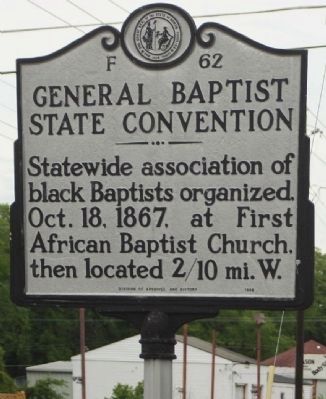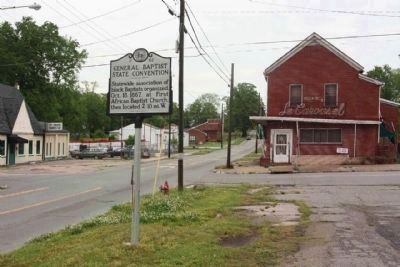Goldsboro in Wayne County, North Carolina — The American South (South Atlantic)
General Baptist State Convention
Erected 1998 by Division of Archives and History. (Marker Number F-62.)
Topics and series. This historical marker is listed in these topic lists: African Americans • Churches & Religion. In addition, it is included in the North Carolina Division of Archives and History series list. A significant historical year for this entry is 1867.
Location. 35° 22.795′ N, 78° 0.112′ W. Marker is in Goldsboro, North Carolina, in Wayne County. Marker is on George Street near Pine Street, on the right when traveling north. Touch for map. Marker is in this post office area: Goldsboro NC 27530, United States of America. Touch for directions.
Other nearby markers. At least 8 other markers are within walking distance of this marker. Gertrude Weil (approx. 0.2 miles away); First Pentecostal Holiness Church Congregation (approx. half a mile away); John Lawson (approx. half a mile away); Company E, 119th Infantry, Goldsboro Rifles World War I Monument (approx. half a mile away); North Carolina Press Association (approx. half a mile away); Foster's Raid (approx. half a mile away); Wayne County Veterans Memorial (approx. half a mile away); Seymour Johnson AFB History / 4th Fighter Wing History Memorial (approx. half a mile away). Touch for a list and map of all markers in Goldsboro.
Regarding General Baptist State Convention. After the Civil War African Americans withdrew from Baptist churches across the state and, two years later, established their own association, the black counterpart to the Baptist State Convention. The withdrawal stemmed, according to John L. Bell’s 1965 article on the topic, from “strong Baptist opposition to social equality” and the desire by both races for separate churches and associations.
In September 1867 a group of ministers led by Meredith Ligon called for an assembly of the minister and two delegates from each black Baptist church in the state. They planned the assembly to coincide with the annual meeting of the white convention from which they received advice and $500 in financial support. The group first took the name “General Association for Colored Baptists of North Carolina.” A schism in 1908 led to the creation of a second association but in 1915 the two recombined in a Union Convention. Known for a time as the Educational and Missionary Convention, the group since 1947 officially has been called
the General Baptist State Convention.
The organizational meeting opened on October 18, 1867, at the First African Baptist Church in Goldsboro. As far as can be determined, no minutes or proceedings survive from that session. Reports of the meeting appeared in the Biblical Recorder and in histories published in 1901 and 1908. The creation of the organization came at a time marked by ignorance, poverty, discouragement, and bitter struggle. Many of the delegates were illiterate, according to prominent antebellum black pastor Harry Cowan, who took part. By 1882, however, the group represented 800 churches and 95,000 members. Today, the convention represents over a half-million members. First African Baptist Church of Goldsboro still owns the tract where the meeting took place (now a vacant lot) but moved to a new church in 1978.
(North Carolina Office of Archives & History — Department of Cultural Resources)
Credits. This page was last revised on July 2, 2021. It was originally submitted on June 28, 2013, by Mike Stroud of Bluffton, South Carolina. This page has been viewed 429 times since then and 13 times this year. Photos: 1, 2. submitted on June 28, 2013, by Mike Stroud of Bluffton, South Carolina.

